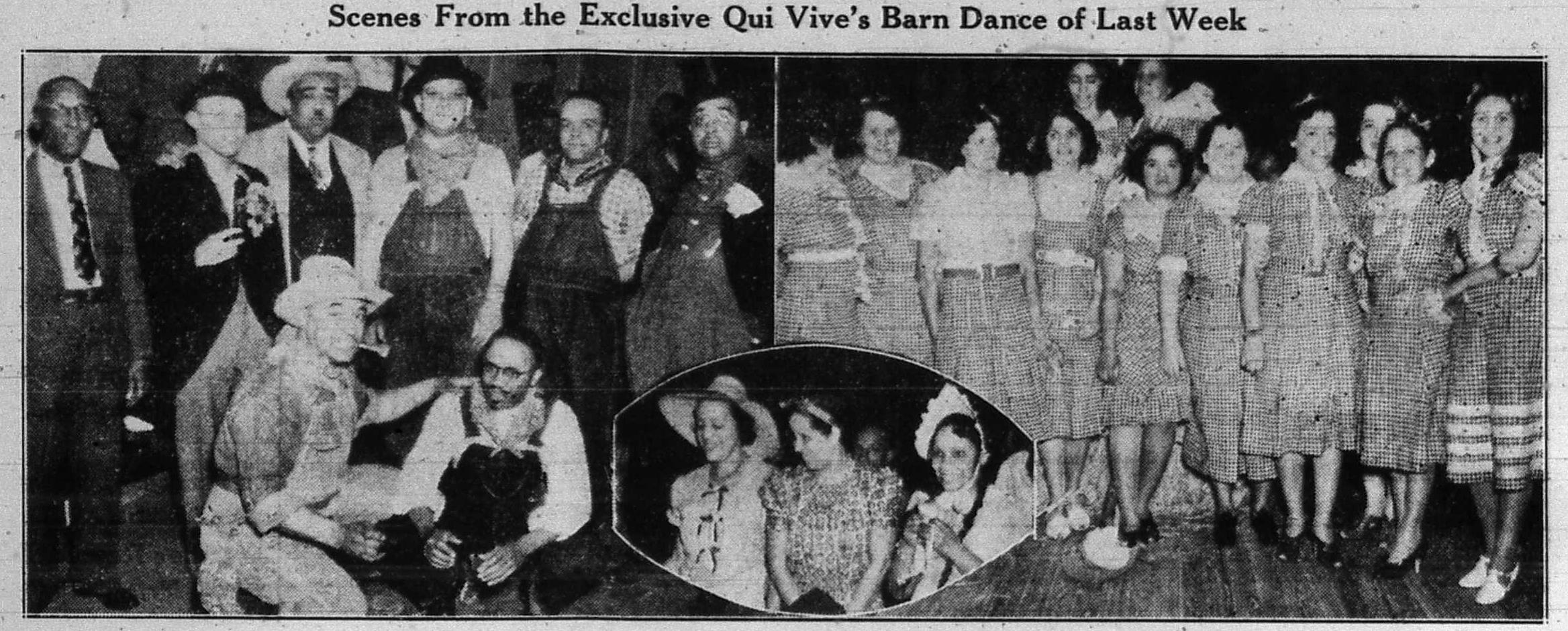 Pictured above, left to right, are: Raoul Maurice (who served as judge), Clifford Belfield, Dr. Taylor Segue, Henry E. Braden, Jr., Dr. Clarence C. Haydel, and Dr. Ernest E. Cherrie. Kneeling are Dr. Ferdinand J. Montegut and Dr. William R. Adams.
Pictured above, left to right, are: Raoul Maurice (who served as judge), Clifford Belfield, Dr. Taylor Segue, Henry E. Braden, Jr., Dr. Clarence C. Haydel, and Dr. Ernest E. Cherrie. Kneeling are Dr. Ferdinand J. Montegut and Dr. William R. Adams.
Among the ladies gathered are Mrs. Ernest Cherrie, Mrs. Henry Braden, Mrs. C. C. Haydel, Mrs. Prudhomme Dejoie, Mrs. Lawrence McMorris, Mrs. Clifford Belfield, Miss Lucille Hutton, Mrs. Percy Perkins, and Mrs. Leonette Weil. Standing at the rear are Mrs. Paul Dejoie, Mrs. Josepha Gregoire, and Mrs. Emile Meine.
In the inset are Mrs. William R. Adams, Mrs. J. A Barnes, and Mrs. Clem Vandage.
As the beautiful old state of Louisiana and all her sons and daughters around the globe prepare for the final climactic days of the Carnival season, there seems to be an abundance of dances, balls, and parties to attend. While the social calendar will be less-filled during the Lenten season as it always is, there is no need to fret for New Orleanians never need much coercing to costume, dance, eat, drink, and pass a good time!
Already anticipating the springtime gaieties which await, presented above are photographs from the ‘Barn Dance,’ given by the Qui Vive Bridge Club in April 1939. Some of the city’s leading citizens – businessmen, doctors, teachers, and others – took a break from their usual suits and ties and everyday-dresses to conjure up the simple fun had ‘down on the farm.’
The Economy Hall on Ursulines Street was decorated with bales of hay, moss, and greenery in keeping with the rural theme. There was even a scarecrow and a chicken coop with two chickens who were probably as puzzled as most New Orleanians would have been to see their teachers, doctors, or society ladies in those get-ups. While the ladies donned simple but pretty cotton dresses, bonnets, and straw hats, the men dug out their overalls, red neckerchiefs, boots, straw hats, and Stetsons for the occasion. The two chickens were given to Dr. Ferdinand J. Montegut and to Mrs. Nathan Johnson, for being the most “typically dressed farm folks.”
Herbert Leary and his Society Syncopators, one of the most popular local orchestras of yesteryear provided the music for the evening, which extended well into the morning. In fact, an “after-dance,” was put together by the popular downtown druggist Clifford Belfield. What a sight it must have been to see Dr. Taylor Segue grab everyone’s attention with his “shoeless toe dance.” He was aided in the merrymaking by Drs. Ernest Cherrie and Ferdinand Montegut. While Dr. Montegut, with his corncob pipe, looked like a sharecropper who had seen “several years of drought and boil weevil ravages,” old Dr. Cherrie was a real “Suthun plantah, suh,” with his silk top hat and frock coat to accentuate his haute-couture overalls!
Felix Ezidore spoke for all of those present when he declared that such a jolly old time among the so-called planters and farmwives should be a part of the annual Carnival celebration. Well great minds think alike, for in February of that year, several well-known citizens gathered together at the home of postal carrier Mr. Wilfred E. Antoine and his wife Alice on Jackson Avenue, where they formed The Plantation Revelers. The Plantation Revelers just celebrated their seventy-sixth anniversary during this Carnival season. It’s unfortunate that none of the attendees of the Qui Vive Barn Dance are still with us to relay stories of that night, the next morning, and into the next day! But as often proclaimed in merry old New Orleans: “Eat, drink, and be merry, for tomorrow we die!” (You can translate into the Southern accent yourself!)
Jari C. Honora
Source: The Louisiana Weekly, 29 April 1939, page 3.



Dr. Ferdinand Montegut was married to my cousin, Mildred Veal Montegut. She was a manager at the Louisiana Weekly Newspaper. Thank you for these pictures; they are precious to me.
Barbara T. Hicks